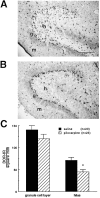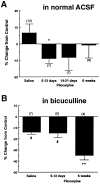Changes in hippocampal circuitry after pilocarpine-induced seizures as revealed by opioid receptor distribution and activation
- PMID: 8987772
- PMCID: PMC6793675
- DOI: 10.1523/JNEUROSCI.17-01-00477.1997
Changes in hippocampal circuitry after pilocarpine-induced seizures as revealed by opioid receptor distribution and activation
Abstract
The pilocarpine model of temporal lobe epilepsy was used to study the time-dependent changes in dentate gyrus circuitry after seizures. Seizures caused a decrease in mu- and delta-opioid receptor immunoreactive (MOR-IR and DOR-IR, respectively) neurons in the hilus and MOR-IR neurons in the granule cell layer. Additionally, diffuse DOR-IR, MOR-IR, and GABA immunoreactivities (GABA-IR) were increased in the inner molecular layer. Using the in vitro hippocampal slice preparation to study the physiological consequences of the anatomical changes, we found that the disinhibitory effects of the mu-opioid receptor agonist [D-Ala2, MePhe4,Gly-(ol)5]-enkephalin (DAMGO) and the GABAA receptor antagonist bicuculline were greatly depressed 5-13 d after pilocarpine injection but returned to control levels within 6 weeks. The amplitudes of monosynaptic evoked IPSCs and the effects of DAMGO on this parameter were also slightly decreased 5-13 d after pilocarpine injection but significantly increased at 6 weeks. DAMGO significantly decreased the mean amplitude of spontaneous IPSCs (sIPSCs) at 6 weeks after pilocarpine injection but not in controls. The delta-opioid receptor agonist [D-Pen2,5]-enkephalin (DPDPE) principally inhibited excitatory transmission in saline-treated animals without affecting either sIPSCs or evoked IPSCs. The DPDPE-induced inhibition of excitatory transmission became more pronounced at 6 weeks after pilocarpine injection. These results illustrate the anatomical reorganization and functional changes in dentate gyrus circuitry evident in an animal model of temporal lobe epilepsy and provide evidence of compensatory changes after trauma to the hippocampal formation.
Figures









Similar articles
-
Presynaptic mu and delta opioid receptor modulation of GABAA IPSCs in the rat globus pallidus in vitro.J Neurosci. 1999 Jun 15;19(12):4796-803. doi: 10.1523/JNEUROSCI.19-12-04796.1999. J Neurosci. 1999. PMID: 10366614 Free PMC article.
-
Spontaneous excitatory currents and kappa-opioid receptor inhibition in dentate gyrus are increased in the rat pilocarpine model of temporal lobe epilepsy.J Neurophysiol. 1997 Oct;78(4):1860-8. doi: 10.1152/jn.1997.78.4.1860. J Neurophysiol. 1997. PMID: 9325355
-
Dissociation of mu and delta opioid receptor-mediated reductions in evoked and spontaneous synaptic inhibition in the rat hippocampus in vitro.Brain Res. 1992 Oct 16;593(2):226-38. doi: 10.1016/0006-8993(92)91312-3. Brain Res. 1992. PMID: 1360320
-
Reduced inhibition of dentate granule cells in a model of temporal lobe epilepsy.J Neurosci. 2003 Mar 15;23(6):2440-52. doi: 10.1523/JNEUROSCI.23-06-02440.2003. J Neurosci. 2003. PMID: 12657704 Free PMC article.
-
Two delta opioid receptor subtypes are functional in single ventral tegmental area neurons, and can interact with the mu opioid receptor.Neuropharmacology. 2017 Sep 1;123:420-432. doi: 10.1016/j.neuropharm.2017.06.019. Epub 2017 Jun 21. Neuropharmacology. 2017. PMID: 28645621 Free PMC article.
Cited by
-
A single dose of kainic acid elevates the levels of enkephalins and activator protein-1 transcription factors in the hippocampus for up to 1 year.Proc Natl Acad Sci U S A. 1997 Aug 19;94(17):9422-7. doi: 10.1073/pnas.94.17.9422. Proc Natl Acad Sci U S A. 1997. PMID: 9256498 Free PMC article.
-
Synaptic input to dentate granule cell basal dendrites in a rat model of temporal lobe epilepsy.J Comp Neurol. 2008 Jul 10;509(2):190-202. doi: 10.1002/cne.21745. J Comp Neurol. 2008. PMID: 18461605 Free PMC article.
-
The Opioid System in Temporal Lobe Epilepsy: Functional Role and Therapeutic Potential.Front Mol Neurosci. 2017 Aug 7;10:245. doi: 10.3389/fnmol.2017.00245. eCollection 2017. Front Mol Neurosci. 2017. PMID: 28824375 Free PMC article. Review.
-
Development of pharmacoresistance to benzodiazepines but not cannabinoids in the hippocampal neuronal culture model of status epilepticus.Exp Neurol. 2007 Apr;204(2):705-13. doi: 10.1016/j.expneurol.2007.01.001. Epub 2007 Jan 9. Exp Neurol. 2007. PMID: 17289026 Free PMC article.
-
Signaling mechanisms of μ-opioid receptor (MOR) in the hippocampus: disinhibition versus astrocytic glutamate regulation.Cell Mol Life Sci. 2021 Jan;78(2):415-426. doi: 10.1007/s00018-020-03595-8. Epub 2020 Jul 15. Cell Mol Life Sci. 2021. PMID: 32671427 Free PMC article. Review.
References
-
- Adams JC. Biotin amplification of biotin and horseradish peroxidase signals in histochemical stains. J Histochem Cytochem. 1992;40:1457–1463. - PubMed
-
- Alreja M, Aghajanian GK. QX-314 blocks the potassium but not the sodium-dependent component of the opiate response in locus coeruleus neurons. Brain Res. 1994;639:320–324. - PubMed
-
- Amaral DG. A golgi study of cell types in the hilar region of the hippocampus in the rat. J Comp Neurol. 1978;182:851–914. - PubMed
-
- Andrade R. Blockade of neurotransmitter-activated K+ conductance by QX-314 in the rat hippocampus. Eur J Pharmacol. 1991;199:259–262. - PubMed
-
- Baez LA, Eskridge NK, Schein R. Postnatal development of dopaminergic and cholinergic catalepsy in the rat. Eur J Pharmacol. 1976;36:155–162. - PubMed
Publication types
MeSH terms
Substances
Grants and funding
LinkOut - more resources
Full Text Sources
Research Materials
